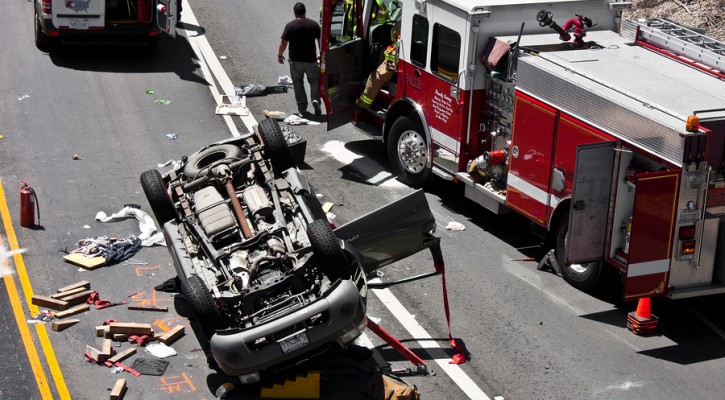Tag Archive: defensive driving class

Five Important Reminders for Teen Drivers
January 3, 2011
Teaching teens how to drive is only the first step of becoming a safe driver. To become confident and competent behind the wheel it is important that they learn defensive driving strategies. Whether they have just received their license or have been driving for a year, defensive driving school is an opportunity to brush up on the rules of the road. Even though teens as new drivers are starting off fresh, as new learners, sometimes they need a little reminding.
Here are five important reminders for teen drivers:
- 1. Failing to prepare is preparing to fail. Surveys conducted by several driving safety organizations have yielded the same result: teen drivers think that they are better drivers than other drivers. Preparing to drive means preparing the vehicle for safety and mentally preparing the driver to be focused on driving, and nothing else, when a teen driver gets into the driver’s seat.
- 2. Seeing signs. Ever notice those things by the side of the road sometimes? Those are meant to be followed. Speed limits are put into place not by some arbitrary decision: road engineers have taken the time to study traffic flow in an area to determine by which speed it is best to drive at.
- 3. Undertakers love over takers. It’s easy for a teen driver to lose his or her cool when another driver cuts them off, or overtakes them. Some motorists go so far as driving fast to catch up to the drivers who did it to them. Simple advice: let them go on. It’s not a race and it’s not worth the risk of a ticket or crash.
- 4. Distraction is two letters away from destruction. A teen driver may feel that they can ABSOLUTELY do something else while driving, while statistics and surveys often prove otherwise. Surprisingly, teen drivers fail to acknowledge that having other teens in the car is one of the biggest distractions from driving. Eat/text/call/change tunes BEFORE starting the car.
- 5.Drinking, drugging and driving DO NOT mix. That goes with prescription drugs and over-the-counter medications that may impair driving ability too. Teen drivers often underestimate the effects of alcohol, and what they don’t know is, when they get a DUI, it haunts them for a long time. It follows them when they look for jobs; apply for scholarships or when they are going to pay for car insurance. Not to mention that it also puts themselves and other motorists at risk.
If you area teen or know a teen, share these important reminders for safe driving, Driver education is continuing education, especially during the teen years.

Driver Education Information That Could Save Your Life
May 21, 2010
Driver education can save thousands of lives. Don’t believe me? Imagine a car and a gun side-by-side. Tell me, which do you think has taken more teen lives? If you feel like the answer should be the gun, think about this for awhile: which one of the two do you see more often day-to-day? While most of the country pays close attention to the subject of gun control or the views of the National Rifle Association, very little focus is given to the number one cause of death for teens- Car Crashes.
The need for driver education is very important because so many of us take the right and the responsibility of driving every day for granted. We travel the roadways and go about our daily routines without the safety reminders we all need. And if you are a new driver— you need the reminders more frequently. We’re going to discuss the basics — the lessons you should be absorbing. This is by no means a substitute for actual driver education, just a summary of the information you may need a refresher on and could save your life.
Buckle Up – Before even starting the car or stepping on the accelerator, always fasten your seat belts. Each year, over 400,000 teen drivers between the ages 16 and 20 get injured in car crashes. Wearing your seat belt will help save your life. It will keep you from being thrown out of the vehicle, lessen the force of impact when hitting the dashboard or other interior spaces in the vehicle and reduce the collision forces on your internal organs. Coupled with air bags, what would be a fatal crash can be reduced to one with only minor injuries. This is also true for your passengers. Make sure they fasten their seat belts. In the event of a crash, if they are not properly belted they can literally become a flying object within the car causing serious injury themselves and other occupants.
Overcrowding – When driving a car, you are not only responsible for your safety, but also for the safety of all your passengers. Being a teen driver already increases your crash risk, but having other teens in the vehicle actually doubles that. Teens make up about 12% of all fatal car crashes in the United States. Overcrowding not only affects the way you drive overall, but causes distractions while driving. In some states, you can be ticketed and fined for driving with minors in the car.
Overloading – A fact you learn in driver education: for every 100 pounds in the car’s trunk, we lower the car’s fuel economy by 2%. This may seem like a low number, but it adds up in the long run. Not only that, but it shifts the center of gravity of your vehicle which in turn affects engine performance, braking distance, and how the vehicle reacts in an emergency. If you’re planning on carrying a lot of stuff — don’t stuff it in the trunk, call a moving van instead.
Emergency Kit – Driver education teaches you all aspects of driving: from trip preparation, operating a vehicle, laws and safety guidelines, defensive driving techniques and handling vehicle emergencies. Always make sure that, when faced with a vehicular emergency, breathe — stay calm. Panicking does not fix your car or improve the situation. If you plan ahead with the proper knowledge, a vehicle emergency tool kit including a spare tire, you’re going to be okay. If you can’t fix the vehicle, remember to have a fully-charged phone, with all your emergency numbers before leaving.
Car Maintenance – Do you know how to check your oil? Is there enough fuel in the tank? Can you check if your tires are worn? Can you check the tire pressure? Are your mirrors adjusted correctly? These are small things you should know how to do after attending driver education — and you should turn this into a routine!
Defensive Driving Techniques – Do you know where your blind spots are and check them each time? Do you keep a space cushion around your vehicle? Is there always a minimum of a two second following distance between your vehicle and the one ahead? Do you look left right left again before entering and intersection? These are some of the many techniques to be a defensive driver and a driver education course covers them.
Driver education is a small step for turning teens into competent drivers on the road. Not only that, but driver proficiency is a skill you will be carrying for life — knowing the small things could save your life in the future! If you have a good attitude towards learning, and you try to learn as much as you can, you are well on your way to becoming a great driver.

Driver Education: Why New Drivers Should Take a Defensive Driving Class
May 27, 2009
Though teens receive driver training prior to being licensed and are subject to Graduated Driver Licensing laws to protect them from statistically high-risk driving situations, training shouldn’t end when teens get their licenses. Reasons for this include:
1. Newly licensed teenage drivers are often giddy with newly acquired freedom. They will assimilate more information once they have become accustomed to the increased level of independence they’ve earned.
2. Teens may pick up bad driving habits, such as carelessness and recklessness, from riding with other teens.
3. Teens who received defensive driving lessons prior to gaining driving experience often have difficulty applying those lessons until they are licensed.
4. New drivers often suffer from information overload; spreading driver training lessons out over time means they will retain more in the long run.
5. Though drivers are statistically less likely to be injured or killed in motor vehicle crashes as they leave their teens, the overall risk remains high throughout the teenage years when compared to other age groups.
Taking a defensive driving course six to twelve months after licensure is very helpful for new drivers. Teens can take the course online or in a classroom. Typical topics include:
- Crash statistics and the physics of vehicle crashes
- Crash prevention techniques
- Occupant protection devices (such as seat belts and airbags)
- Driving under the influence of alcohol
- How to share the road with large trucks, motorcyclists, and pedestrians
- Dealing with stress and drowsiness while driving
- The hazards of speeding
- An overview of traffic laws in your state
When teens take a defensive driving class, they have the opportunity to apply concepts that may have seemed abstract prior to licensure. For example, crash prevention techniques are easier to appreciate once the driver has experience in maneuvering a vehicle; unlicensed teens are unlikely to understand how much stress and sleepiness negatively impact their driving abilities. However, as newly licensed drivers, teens haven’t been driving long enough to have ingrained driving habits, so they still have an opportunity to eliminate unsafe practices and become safe drivers.

Real Life Hazards Best Driving Experience for Teens
November 26, 2007
Having rain in the forecast is sometimes a good thing when teens are taking a defensive driving course like the one the Mid-Ohio Sports Car Course offers. It just adds one of the elements of driving conditions that teenagers should be prepared for as they learn to drive, especially defensively.
This defensive driving course is for both parents and teens and it can be quite an eye opener, not only for the new teen drivers but for the experienced parent as well. Teen drivers and their parents are put through the paces with such drills as braking when the roads are wet, changing lanes in an emergency and even how to get out of a skid. For the skid drills, there are special cars that are purposely set up to skid so that the teens can learn what it feels like, the panicky feeling they get when it happens and how to push past all that and come out of the skid safely as possible.
When parents don’t have as much time as they should to teach their teens practical on-the-road driving, this defensive driving course can help fill in some blanks. After all, parents are not likely going to allow their teens to skid or drive in the rain in the family car! However, with the course, the instructors want teens to screw up because it will be in a controlled course and they will learn from the mistakes as well as that of others too.
Parents don’t know everything, although they may pretend that they do with their teenagers. So this defensive driving course is a definite eye opener for both parties. Teenagers will have to deal with situations that the parents will never think of, which can be a bit disconcerting for the grown-ups. In a country where as many as 25-30 teens die every day due to vehicle accidents, adding a driving test to your “resume” is a smart move.
While teens crave the independence that the open road will bring, they will not likely think about any potential road hazards they may encounter. They are thinking about switching the CD in the car or finding the windshield wiper switch. The problem is that one small distraction could cause a situation where an accident can occur. With the defensive driving course, hopefully those lessons will kick in instinctively for teens and avert a disaster.
That is the whole purpose for the defensive driving course. It is but another tool of many in the quest to build a safe teenage driving population. The only thing that would be better is making driver’s education a mandatory class once again in school so that each and every teen will have an equal opportunity to learn safe driving habits.
